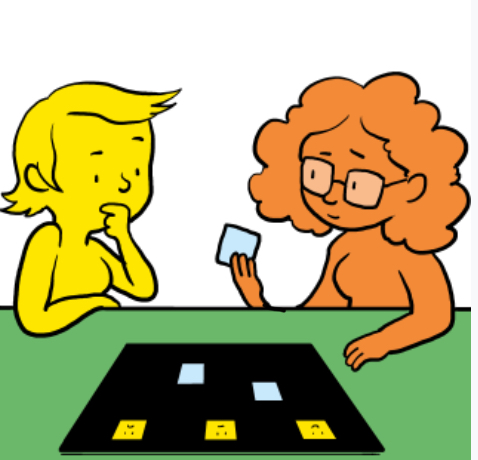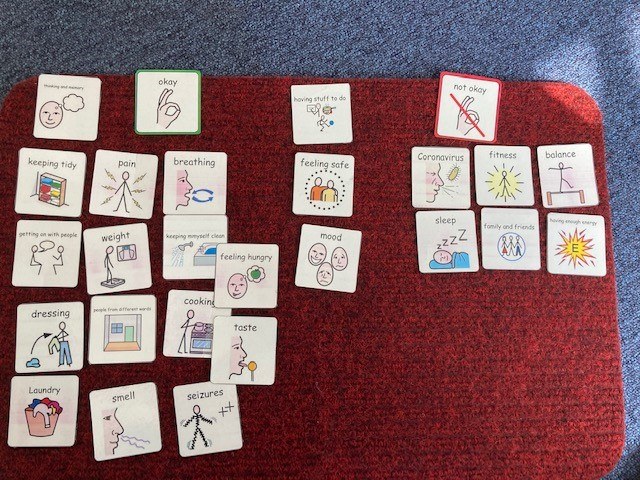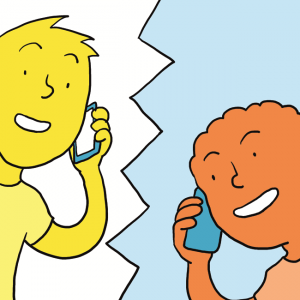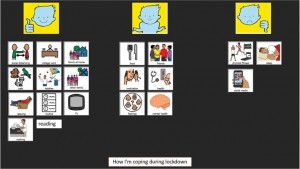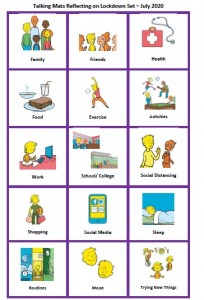Many thanks to Peter Just, Head of External Affairs, RCSLT and Padraigin O’Flynn, External Affairs Assistant, RCSLT for this blog describing the newly launched UK-wide RCSLT Survey, which includes free Talking Mats resources to support those with communication difficulties to have their voices heard.
Like many of you, the Royal College of Speech and Language Therapists (RCSLT) has been worried about the impact of COVID-19 on people with communication and swallowing needs. Based on what we’ve heard from our members, service user organisations and service users themselves we’ve been very concerned about how the UK-wide lockdown (March-June 2020) affected people’s access to the speech and language therapy they and their families and carers need.
To help us understand the issue better and to inform our response, we’ve just launched a UK-wide survey. Following consultation with service user organisations, the three key questions we’re asking are:
- How did lockdown affect your speech and language therapy?
- What impact did this have on you?
- What are your thoughts about the future?
From the start, we were clear: we wanted the survey to be as accessible as possible to as many people as possible, no matter how they communicate and no matter what their communication preference is. Over the past couple of months, we’ve worked with members to produce the survey in a range of accessible formats.
We’re particularly delighted that one of those formats is Talking Mats – and we’re very grateful to Lois and Laura for all their advice and support . As you will know better than anyone, the mats will enable people to give us their views and tell us how they’ve felt and are feeling. We are delighted the mats will provide people with the means to self-advocate – this will add a richness to the survey findings that they might otherwise lack.
We’ll be working with service user organisations to promote the survey to their networks. But we’d also really like your help too. Please share the survey and encourage as many people as possible to fill it out. The more voices we hear, the more stories we collect and the more responses we receive, the greater the impact of the survey findings will be.
Those findings, which we hope to publish early in the New Year, will be used to influence Governments, Parliaments and Assemblies across the United Kingdom. The case that will be making to ministers, officials and parliamentarians – that people must have access to the speech and language therapy they need – will be all the stronger for it being based on service users’ lived experiences. The very powerful testimony that the mats will provide will strengthen that case even further.
The survey is open until 5pm on Friday, 8th January 2021 and you can find more information about it here:
https://www.rcslt.org/learning/has-coronavirus-affected-your-access-to-speech-and-language-therapy
We hope you find the mats useful and if you had any queries or wanted any more information, please let us know. We look forward to working with you to help make a difference to the lives of people with communication and swallowing needs.
Peter Just, Head of External Affairs, RCSLT
Padraigin O’Flynn External Affairs Assistant, RCSLT
We are really looking forward to our first ever Talking Mats Twitter Chat on Thursday 01.10.20 from 7.30 – 8.30pm!
It will be a great opportunity to share experiences and ideas – here are the questions we will be asking:
This will be followed by a brief summary of the key learning points from the discussion. Join in and remember to use #TimeToTalkTM in all your comments – we look forward to chatting with you all!
Following on from last week’s guest blog, Edith Barrowcliffe from the Action Group describes how she has continued using Talking Mats throughout lockdown. Please note that the image used in this blog is from a mock session and has been taken for publicity purposes only.
In the second week of March I was running a 9 week old pilot counselling service (HearMe at The Action Group) for adults with cognitive and/or communication difficulties, supported by Talking Mats.
A week later lockdown catapulted me into remote working and demonstrated just how crucial Talking Mats were. Without access to the digital app or a suitably high resolution webcam my first online sessions were conducted without them. One client immediately began struggling to retain the thread of their subject matter.
I quickly rigged up a secondary webcam, allowing me to shift between my face and a clear view of the physical mat on my desk. Clients direct me how to place the symbols for them.
I’ve recently acquired a Talking Mats digital license and am pleased to find I can add in additional images. My experience with the physical cards is that allowing the client to direct the session often means searching through multiple different sets or hastily drawing new images. We move at a slower pace because of this but it seems to be an important way of giving weight and attention to whatever the client (Thinker) brings. My fantasy version of the digital talking mats app would include an image search function allowing me to rapidly search all the symbols in all the sets, pick one and caption it appropriately mid-session!
The client I mentioned above uses Talking Mats in this very freeform way – when they tell me something I ask if they want to put it on the mat and they will reply yes, or no. Once I’ve located or drawn the image they tell me where to place it. Towards the end of the session we review the mat, photograph it, and I send them the picture.
Another client uses a more structured approach. I present a choice of symbol sets based on topics that seem to be important to them (eg home environment, relationships, mobility). They select a topic and we begin a more typical talking mat, giving us a framework and focus to explore their feelings around each symbol. After a while the client/Thinker moves on to other emotionally weighted topics unrelated to the symbol set and we transition into something more akin to “regular” counselling – albeit with simplified, concrete, reflections of the kind proposed by Garry Prouty [1] Yet the Talking Mat seems to provide a “way in” to these deeper feelings that we otherwise don’t reach.
Not everyone uses Talking Mats. Lockdown has limited my capacity to offer it – not all clients have a computer/tablet for video calls and some clients actively prefer the phone. I’m continuing to learn, explore and find my way with this very diverse client group, but there is no doubt that Talking Mats opens up emotional exploration for some who might not normally manage it.
Edith Barrowcliffe, Hear Me, The Action Group
With thanks to our funders and partners for making this work possible – Hospital Saturday Fund, The Action Group Board, Leith Benevolent Society, Port o’Leith Housing Association, and The Scottish Government. And to the team at Talking Mats for their support and help!
[1] [PROUTY, G. (2008) Pre-Therapy and the Pre-Expressive Self. In: PROUTY, G. (ed.) Emerging Developments in Pre-Therapy. Monmouth: PCCS Books; also PÖRTNER, M. (2007) Trust and Understanding. Revised Ed. Ross-on-Wye: PCCS Books, pp82-85].
A new, updated version of our Digital app, will be available in the New Year. You can download a free taster version of our app here:
https://www.talkingmats.com/product/talking-mats-taster/
For more information about using Talking Mats remotely, check out this recent blog:
https://www.talkingmats.com/using-talking-mats-remotely/
Many thanks to Edith Barrowcliffe from The Action Group for sharing her experiences of using Talking Mats to support counselling with adults who have cognitive or communication difficulties. Watch this space for Edith’s follow-up blog next week which will describe how she has continued to use Talking Mats during lockdown. Please note that the image used in this blog is from a mock session and has been taken for publicity purposes only.
Eleven years ago, I began working at The Action Group with adults who have additional support needs and was struck by how many had mental health difficulties that they were getting little help with. Sadly, with services scarce enough for the “mainstream” population, I could see why.
The issue resurfaced for me in 2016 when I began training as a counsellor. I kept returning to whether talking therapy was possible with those who had difficulty communicating – or even thinking about – their feelings.
Then in 2019, I attended Talking Mats training. Immediately excited by the potential for emotional connection, I signed up for the advanced “Keeping Safe” training and approached The Action Group’s CEO with the beginnings of a plan.
I’m fortunate in working for an organisation willing to take new ideas and run with them. Within six months I was embarking on a pilot project, called HearMe, offering counselling to adults with cognitive or communication difficulties, with Talking Mats as a key method to help overcome those barriers. Within a fortnight of opening the service was full to its limited capacity and had a waiting list!
The work has been experimental, learning as I go and adapting to the particular needs of each client. To conduct initial assessments, I’ve assembled symbols based on “Thoughts and Feelings” from the “Keeping Safe” pack. We return to this to review progress. Most clients have used a top scale of “True”/ ”Not True” with statements “about me” for the assessment. We always begin with a practice mat based on more neutral material, allowing the client (Thinker) to learn what’s involved and me to gauge whether the mat is right for them. This is crucial – one client found a way to frame everything we placed on the mat positively even when they’d been able to tell me the opposite was true a moment before! In this case we simply used each symbol as a focus for exploration.
We’ve kept the number of questions relatively small, but the assessment can take two or three sessions to complete as clients often respond quite deeply to the symbols.
Some more verbally able clients move on to a more “freeform” style of counselling as we progress, relying less on the mat to open up. But even in these cases having symbols on hand can be helpful. One client brought up the topic of sex – then apologised and asked if it was OK to talk about it.
“It’s fine,” I was able to reassure her, producing the relevant symbol. “Look, we even have a picture for it”. She laughed and visibly relaxed, the card giving her tangible evidence that the topic was allowed.
It’s still early days, but from the feedback we’ve received so far, the project really seems to be helping people to open up, express feelings they’ve never given space to before, and explore ways they want to change their lives. The power of simply being heard.
Edith Barrowcliffe, Hear Me, The Action Group
With thanks to our funders and partners for making this work possible – Hospital Saturday Fund, The Action Group Board, Leith Benevolent Society, Port o’Leith Housing Association, and The Scottish Government. And to the team at Talking Mats for their support and help!
Follow the link below to find out more about our Keeping Safe training (now available online) and resource:
https://www.talkingmats.com/keeping-safe-a-new-talking-mats-resource-available-to-purchase/
We are delighted that we now have around 20 members of our Talking Mats (TM) research group. Members come from a variety of countries including the United Kingdom, Denmark, Cyprus, Germany, Sweden, Australia and Japan! We are a mix of academics and practitioners, with many combining both roles. So far we have spent time getting to know one another via video sessions and thinking about how the group might work.
We have decided our initial focus will be thinking about ways of analysing the data that is generated from conversations that are supported by TMs. This idea was suggested by Nikita Hayden. Nikita is a PhD student at the University of Warwick exploring the outcomes of siblings of children and adults with learning (intellectual) and developmental disabilities. Part of her research has used TMs with children with severe learning disabilities and their siblings to further understand their sibling relationships.
The types of data generated have been rich, vast and varied, leading to an overhaul of Nikita’s initial plan to analyse her TM data. This has raised questions about how TMs are interpreted and analysed in a research context, and what scope there is for our group to explore and synthesise the analysis potential of TMs. This is a question that the TM team is often asked and so having some information on the different options would be useful.
TM discussions generate various types of data, including:
- The photograph of the mat (which symbols are placed under the various columns);
- The conversation generated during the discussion;
- The body language and facial expression of the ‘thinker’;
- The speed of placement of symbols;
- The symbols that are moved following feedback etc.
We would like to review existing publications that have used TMs as research data and think about possible methods of analysis. This may include consideration of both within and between group research analysis techniques. It may also involve exploring the potential of both traditionally qualitative and quantitative analysis techniques, such as thematic or conversation analysis, or by drawing on data from the symbol placements to provide pre-post evaluation data.
We hope to generate a list of guidelines about what you might need to take into account when considering how to analyse these data. A challenge when analysing TMs data, is how to handle the variation in the types of data collected between participants. For example, some participants may place a large number of symbols, whereas other participants may have placed relatively few. This raises questions about how we deal with ‘missing data’. In small samples, how can we conduct a pre-post evaluation where some symbols are missing for some participants? If some participants use a five-point scale, and some use a two-point scale, what numerical analysis potential is there, if any? How can we appropriately derive qualitative themes from across our sample if some of our participants were minimally verbal? What sorts of non-verbal cues have been analysed in research using TMs?
Please do share any ideas or questions you have with Jill Bradshaw, our Talking Mats Research Associate – J.Bradshaw@kent.ac.uk
As a group of Allied Health Professionals (AHPs) working in a secure hospital we recently embarked on a mini project using Talking Mats to check in with our service users with learning disabilities during Covid-19. We collated the evidence from our respective professional bodies (Royal College of Occupational Therapy, Royal College of Speech and Language Therapy, Chartered Society of Physiotherapists and British Dietetic Association) in terms of changes that people might experience if they’d had Covid-19 and produced a talking mat around these.
It quickly dawned on us that we might be on to something here, and that creating an opportunity to ‘check in’ more broadly with our service users would serve a useful purpose, so we added some additional categories around changes to routine, psychological wellbeing and feeling safe.
This was my colleagues’ first experience of using talking mats, and their faces when I turned up clutching my 99p actual doormat were a picture! I introduced them to the theory behind the mat and its presentation and harped on about the benefits in terms of attention, comprehension, non-threatening interaction, initiation and structuring narrative; they nodded supportively.
We set off across our learning disability wards in multi-disciplinary pairs and all but a few of the service users agreed to have a chat with us. My colleagues commented that they were pleasantly surprised by the engagement and the amount and novelty of the information gained; we identified things that the service users hadn’t told anyone because they hadn’t been asked that question!
In talking to others we were asked why weren’t rolling this out in a partner secure hospital for people with mental health conditions? ‘no reason really, we just haven’t got there yet’ we answered. Then came the…. but we can just do it like a questionnaire with them. This question wasn’t, and in my experience isn’t ever ill meant. It comes from a place of naivety in relation to the presence of communication difficulties in people with mental health conditions and because of that, lack of exposure to different professional groups such as Speech and Language Therapy and the skills and approaches we have to offer. Skills in gaining and holding someone’s attention. Skills in decreasing pressure in communication situations. Skills in enabling time, space and ways in which people can initiate their thoughts.
The Multi-Disciplinary Team (MDT) working around the project has enabled me to show others how talking mats can support their practice. It has enabled them to see how a very simple and non-threatening visual tool can open up conversations and lead to information that the service users hadn’t shared before, in a way that a face to face conversation doesn’t.
Thanks to Jo Brackley, Clinical Lead, Speech and Language Therapy Secure Services at Cumbria, Northumberland Tyne and Wear NHS Foundation Trust for this inspiring blog – which demonstrates when we shift the way we listen and gather information from patients we get a different result and improve the quality of information and communication . If you or your team want to consider Talking Mats training then we can provide this for organisations . At the moment we can take a cohort through our online course together and then arrange a zoom call to discuss application to your work setting – email info@talkingmats.com for more information.
Our first Talking Mats advanced online module has launched. We are pleased we had developed our online foundation training well before lockdown. There has been such great feedback from people who have completed our online foundation course and they have been asking for more. They like the bite size chunks, being able to pace their own learning and the reflective practice approach. Now we are adding to our online course with an advanced Talking Mats module focusing on Talking Mats use in safeguarding. This course is structured around the Talking Mats Keeping Safe resource and how to use it.
The Keeping Safe Talking Mats resource was developed to check in with people and find out how their lives are going. It uses a holistic framework to do this and the conversation it supports is structured around three topics: 1) well-being; 2) relationships; 3) thoughts and feelings. The resource was trialled and tested in projects involving over 700 practitioners. Originally, it was designed for people with learning disabilities but feedback has been that it has been helpful with a wide range of people including, those with stroke, head injury, dementia and mental health issues.
The advanced online module involves 2 to 3 hours of learning that you do at your own time and pace. It involves short talks, reading, videos and reflective practice activities. You will develop confidence in using the resource as well as an understanding of relevant issues, such as diagnostic overshadowing, developing the capacity of individuals to raise concerns, the impact of trauma. You will be encouraged to reflect on how you can apply the Talking Mats Keeping Safe resource to your own area of practice
To apply for the course, you must have completed your foundation Talking Mats training. If you haven’t completed this training book now. Access to this advanced course will begin on the first of every month and you will have 6 weeks to complete it.
Book your place now. The cost is £85 for the course and the Keeping Safe resource and £55 if you already have your Keeping Safe resource and just want to do the training.
I am passionate about connection, about communication, about music. That’s what drives me forward. I have been playing the cello for over 40 years; I’ve been playing professionally for about 25 years. Having the privilege and honour of playing at the bedside of people who I cared about who were nearing the end of their life changed my perspective on the importance of music. I realised that there was far more to music and to my playing the cello than ‘performing’ – than my ego. I learned that music could touch all who were involved; listeners and musicians alike in a deeply profound way – but I wasn’t sure quite HOW to harness music in an effective manner to insure I was not simply performing. This realisation took me into a wonderful course in the USA – ‘Music and Transitional Healing Program’ (MHTP.org) back in the early 2000s. I found what I’d been looking for – I learned about different types of music and rhythms and modes and when to play them depending solely on the state of the listener. I learned about entrainment and other very important tools in order to better ensure that all important connection with the listener. I learned to meet the listener where they are in the THAT moment – to aim to get in sync with them – and to then respond to whatever happens.
This learning eventually and unexpectedly led me to a PhD studentship at the University of Stirling where I played the cello live and pre-recorded at the bedsides of care home residents with dementia who were in palliative care, and someone who was closely connected with them. I wanted to know how the recorded vs live music might affect the listener’s connection with one another.
During my PhD, I trained in Talking Mats – I have since bought quite a few of the packs available and remain convinced regarding the effectiveness of this simple tool for enhancing connection and communication.
Now I am moving into the virtual world that we all find ourselves in. Lock-down has allowed me to have more time to fully enjoy playing my cellos (I specialise in baroque cello as well as modern cello – and I have a 6-string electric cello as well!). This strange gap in time has also prompted me to finally building a (still evolving) website (https://drclairegarabedian.com/) and to schedule events related to my work with music and people living with dementia (https://drclairegarabedian.com/events/). Although I have previously offered similar events live, this will be a new experience/learning curve in the virtual world!
I am currently managing a wonderful project through the Edinburgh InterFaith Association (https://www.edinburghinterfaith.com/time-to-talk); ‘Time to Talk’ – this Covid-19 listening service is funded Scottish Government funded through July 2020, and provides a skilled, trained, experienced listener for all care home residents and their families living in Scotland (11:00am – 7:00pm, 7 days a week).
I hope to see you at one of my upcoming events – please sign-up on my website for news of upcoming events and offers. Stay safe and healthy everyone!
Thanks to Claire Garabedian fro this guest blog and good luck from all of us in her new venture
I stole the lyrics and altered them slightly, but this is the song line that has kept popping into my head over the past few weeks as we find ourselves hurtling through the different phases of lockdown easing. The rules and recommendations that have guided our lives for the past 3 months or so are changing rapidly and change can be difficult. Communicating how we feel about change and life in general can be difficult.
We have seen creative uses of our resources and have really enjoyed learning how they have helped young people and adults express how they coped throughout lockdown and beyond. Kirsten Lamb’s guest blog about Returning to School After Lockdown is just one example of how the TM framework was invaluable in gaining the opinions of young people as they adapted to ongoing changes over which they had little or no control.
https://www.talkingmats.com/returning-to-school-after-lockdown/
Another Talking Mats practitioner recently tweeted this mat that she did with a college student, showing how Talking Mats helped structure thinking about how life was going.
We felt a single resource was needed to help kick start a conversation around Life (but not as we know it; I am sure that’s a song too) looking at the following themes:
- Family / Friends / Bubbles / Social Distancing
- Health
- Mood / Emotion
- Sleep
- Exercise
- Work
- School / College
- Activities
- Shopping
- Routine
As with every Talking Mat you can change the top scale to be more or less concrete, you can use blanks to add in things that we haven’t included, you can leave things out that aren’t relevant. Download your free printable pdf here: LOCKDOWN SET
We look forward to hearing stories from our Talking Mats Community on how you helped others express themselves (definitely another song!)
Thanks to everyone who joined our second Zoom session on using Talking Mats remotely. The notes from the first session can be found here. It was great to share experiences and to welcome our international Talking Mats’ community too. We were impressed by your ingenuity and creativity in making TMs work remotely and there were lots of great stories of the use of it in practice. Here is a summary of the main points, with special thanks to Sam Quinn for explaining how to use 2 devices in order to see the person as well as the Mat.
Using a second device on a virtual Talking Mat session can help you to capture the thinker’s reaction to the mat and symbols. This can be particularly useful for recording videos to watch again later (obviously with the appropriate video consent). To do this on a tablet or mobile device and assuming you have already set up the meeting:
1. Open the Talking Mat app on your first device and prepare the symbol set you would like to use. When you are finished, minimise this app.
2. On the same device, open your communication app (Zoom, Microsoft Teams) and join your meeting.
3. Click ‘share’ and ‘screen’, then switch to the Talking Mats app. You should be able to control the Talking Mat while other people in the meeting can see it. It is advised you mute your volume to avoid interference.
4. On your second device (this could be a laptop, tablet or mobile) use the meeting ID that you sent to yourself to join the Zoom meeting.
5. On your second device, there is an option to split the screen so you can see both the thinker and the Talking Mat at the same time.
6. If you are using a PC or laptop as your second device there may be an option to record the session if you wish to do so.
Device one (tablet or mobile) hosts the Zoom/Teams meeting and is used to control the Talking Mat.
Device two (tablet, mobile or PC) acts as a second guest in the meeting and allows you to view the Mat and the thinker at the same time and record the session.
You can invite another device using Near Me/Attend Anywhere.
Remember you can still use the physical resources by holding the Mat to the camera and asking the thinker to tell you where to place the option on the Mat. Some have done this successfully.
You can try iPad mirroring https://tactustherapy.com/telepractice-how-to-mirror-apps-computer/ You can download a guide for how to do this if you follow the link.
A couple of people reported setting up Talking Mats by using https://miro.com/ and https://jamboard.google.com/ but, word of warning, it takes time to do this.
Remember you can use your digital login for the app (from Apple Store) and through the web browser http://www.digitaltalkingmats.com/ – make sure you enable FLASH.
And finally just to remind you that you can currently get a discount on the Digital Talking Mats resource:
DISCOUNTED DIGITAL TALKING MATS REQUEST FORM
Our online Foundation training is taking place throughout the year. Forthcoming courses are starting on 22nd September, 6th October and 3rd November. Reserve your place here.
If this is all new to you and you want to find out more about it, please listen to a webinar arranged by the Health and Social Care Alliance where Margo and Lois talk about Digital Talking Mats and how it can support wellbeing: https://www.youtube.com/watch?v=84CY3QFFa_g
 Online training login
Online training login 

